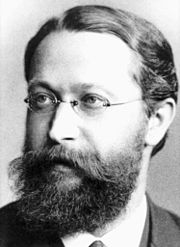Karl Braun
| Karl Ferdinand Braun | |
|---|---|
 |
|
| Born |
6 June 1850 Fulda, Electorate of Hessen, Germany |
| Died | 20 April 1918 (aged 67) Brooklyn, New York, U.S. |
| Nationality | German |
| Fields | Physics |
| Institutions |
University of Karlsruhe, University of Marburg, University of Strassburg, University of Tübingen, University of Würzburg |
| Alma mater |
University of Marburg, University of Berlin |
| Doctoral advisor |
A. Kundt, G. H. Quincke |
| Doctoral students |
L. I. Mandelshtam, A. Schweizer |
| Known for | Cathode ray tube, Cat's whisker diode |
| Notable awards | Nobel Prize in Physics (1909) |
Karl Ferdinand Braun (6 June 1850 – 20 April 1918) was a German inventor, physicist and Nobel laureate in physics. Braun contributed significantly to the development of radio and television technology: he shared with Guglielmo Marconi the 1909 Nobel Prize in Physics.
Braun was born in Fulda, Germany, and educated at the University of Marburg and received a Ph.D. from the University of Berlin in 1872. In 1874 he discovered that a point-contact semiconductor rectifies alternating current. He became director of the Physical Institute and professor of physics at the University of Strassburg in 1895.
In 1897 he built the first cathode-ray tube (CRT) and cathode ray tube oscilloscope. CRT became the cornerstone in developing fully electronic television. In the early 21-st century the CRT technology started to be replaced by flat screen technologies (such as liquid crystal display (LCD), light emitting diode (LED) and plasma displays) on television sets and computer monitors. The CRT is still called the "Braun tube" in German-speaking countries (Braunsche Röhre) and in Japan (ブラウン管: Buraun-kan).
...
Wikipedia
